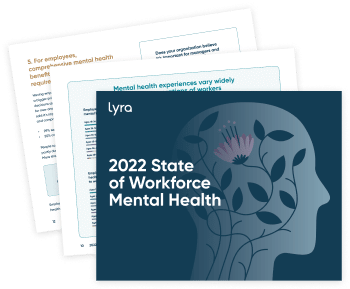2022 Workforce
Mental Health
Employee mental health is declining
of employees experienced at least one mental health challenge over the past year
Most common workforce mental health challenges
Top factors affecting employee mental health
More employees are seeking care and opening up about mental health at work
More employers are focusing on workforce mental health
said providing mental health support for their people was a higher priority for their company in 2021
expect it to stay that way over the next 3 years
percent said their company plans to change its workforce mental health strategy in 2022
Mental health benefits are a bigger factor in people’s decisions to join or leave a company
said it’s important that a prospective employer offer “robust and comprehensive mental health benefits”
said they’d “stay at a job because it provides robust and comprehensive mental health benefits”
Employees crave flexibility, but don’t often have it
of employees said flexible options like remote work or work-from-home days are “very important” to them
said their company offers flexible work options such as remote work or work-from-home days
Mental health experiences vary widely across generations of workers


For more insights into the challenges, priorities, and attitudes shaping mental health at work today, read our 2022 State of Workforce Mental Health report.